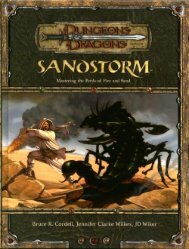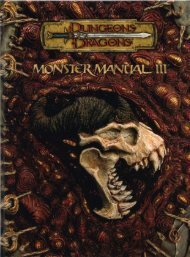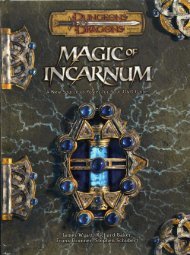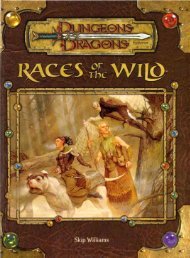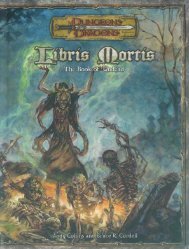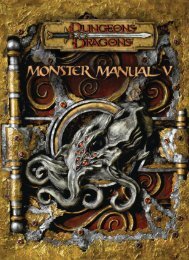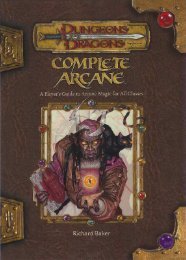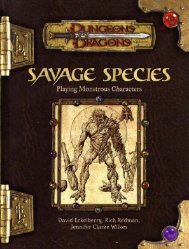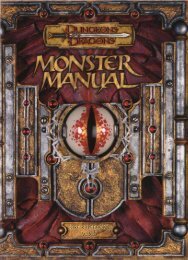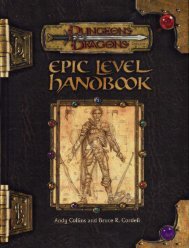Exemplars of Evil
Exemplars of Evil
Exemplars of Evil
Create successful ePaper yourself
Turn your PDF publications into a flip-book with our unique Google optimized e-Paper software.
CHAPTER 1<br />
GREAT<br />
VILLAINS<br />
8<br />
Illus. by R. Gallegos<br />
alter ego and infiltrated the Honest Men, a guild <strong>of</strong> criminals<br />
known for their skill at assassination. By day, she is the<br />
beautiful and obedient princess; by night, she is the White<br />
Lady, commanding a legion <strong>of</strong> killers to wreak havoc in her<br />
brother’s lands. Her agents extort nobles, ambush shipments,<br />
smear <strong>of</strong>ficials by spreading false rumors, and eliminate anyone<br />
who comes close to<br />
discovering her identity.<br />
Each time her minions<br />
act in her name, they<br />
leave behind her calling<br />
card: a white rose.<br />
NON-EVIL<br />
VILLAIN<br />
“Execution is murder. If we<br />
permit it, the blood <strong>of</strong> the<br />
accused stains our hands,<br />
making murderers <strong>of</strong> us all.”<br />
Villains need not be evil<br />
or neutral. Good-aligned<br />
characters can stand in direct<br />
opposition to the PCs.<br />
Such conflicts can arise<br />
over differences <strong>of</strong> opinion,<br />
unwitting alliances<br />
with evil manipulators,<br />
or moral compromises<br />
that are struck to achieve<br />
a noble end.<br />
Non-evil villains genuinely<br />
believe that their<br />
actions reflect their own<br />
upright principles. Their<br />
point <strong>of</strong> view might be<br />
shaped by philosophical<br />
differences with the PCs,<br />
or by confusion about<br />
another character’s motives.<br />
Some good-aligned<br />
villains are unaware that<br />
they serve evil masters, unintentionally spreading malevolence<br />
as they pursue their lord’s cause. Adamant in<br />
their beliefs, they do not or cannot see the danger in what<br />
they do.<br />
Advantages: Non-evil villains make for unusual foes,<br />
allowing you to use a new range <strong>of</strong> characters and creatures.<br />
For example, Dungeon Masters seldom throw paladins against<br />
the PCs, and most adventurers would find it unthinkable to<br />
slay a celestial. However, with the non-evil villain archetype,<br />
creatures that ordinarily would be allies <strong>of</strong> the PCs instead<br />
become their enemies. The party must find a way to fight<br />
these opponents without killing them, or the PCs risk committing<br />
an evil act themselves.<br />
Disadvantages: For a non-evil villain to be effective,<br />
he must believe that his actions are correct. At heart, he<br />
is a good character, and he does what he thinks is good.<br />
No matter how zealously he strives for his goal, no matter<br />
how misguided or closed-minded his actions, he will not<br />
commit atrocities—at least, not unless he can rationalize<br />
The White Lady strikes again<br />
them. Odds are that if the PCs can show a non-evil villain<br />
the error <strong>of</strong> his ways, he will stop doing whatever is causing<br />
the trouble. That turn <strong>of</strong> events might be good for the<br />
campaign setting, but it can kill the drama and excitement<br />
for the players. To avoid this plot development, make sure<br />
that the villain can justify his actions. His motives should<br />
be sound, even if his objectives<br />
are not.<br />
Tactics: A lawful good<br />
villain might be a fanatic,<br />
forcing his views on<br />
others and making enemies<br />
<strong>of</strong> those who do not<br />
subscribe to his beliefs.<br />
Alternatively, to protect<br />
his nation and his people,<br />
a lawful good villain might<br />
launch a preemptive war<br />
against a rival nation in<br />
the name <strong>of</strong> freedom and<br />
security.<br />
Whether he knows it<br />
or not, a non-evil villain<br />
might be the minion <strong>of</strong><br />
an evil master. Perhaps he<br />
commits terrible deeds—<br />
burning villages, executing<br />
peasants, or sending innocents<br />
into exile—because<br />
he is following the orders<br />
<strong>of</strong> a superior. He might<br />
have misgivings about his<br />
duties, but above all he remains<br />
loyal to the crown, the<br />
high priest, or some other<br />
authority figure.<br />
Example: When her<br />
brother was wrongly accused<br />
<strong>of</strong> murder and executed, the<br />
fiery agitator Merla Thorngage<br />
(CG female halfling<br />
fighter 2/rogue 6) vowed<br />
to oppose the practice <strong>of</strong> capital punishment. In her mind,<br />
whenever the state executes a miscreant, no matter how<br />
shocking his crime, it descends to the criminal’s level.<br />
Merla also believes that the government represents the<br />
interests <strong>of</strong> the public, so allowing the executions to continue<br />
makes the people equally guilty. Therefore, she and<br />
her followers liberate convicted criminals, breaking into<br />
dungeons and smuggling prisoners out <strong>of</strong> the city so that<br />
they can start new lives elsewhere. Although her views are<br />
noble, Merla does not realize that the wretches she helps<br />
to free simply pick up where they left <strong>of</strong>f: stealing, murdering,<br />
or doing whatever sent them to the gallows in the<br />
first place.<br />
RIVAL<br />
“You made me what I am. Now it’s time to pay the price.”<br />
A rival villain is bound to the player characters. Her objectives<br />
are tied to the PCs because her primary role is to oppose



